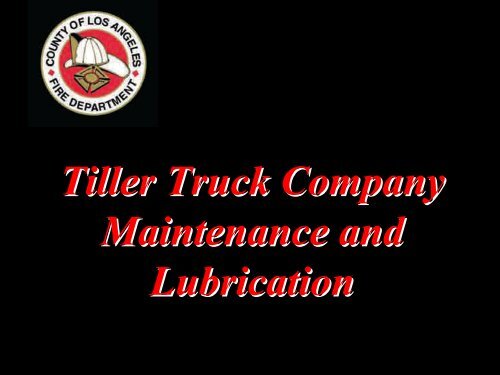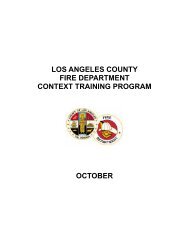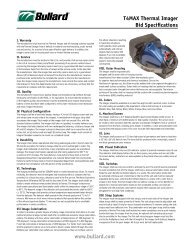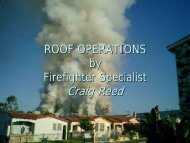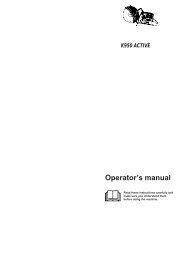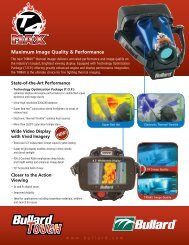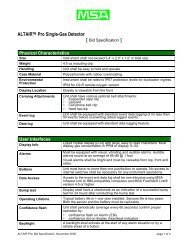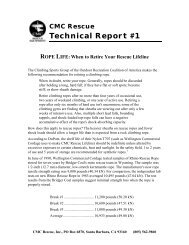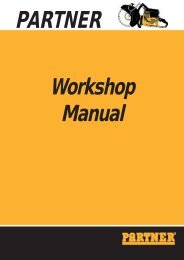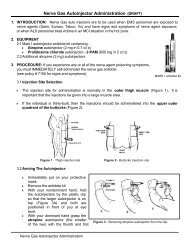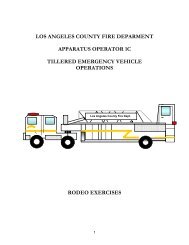Truck Maintenance and Lubrication
Truck Maintenance and Lubrication
Truck Maintenance and Lubrication
You also want an ePaper? Increase the reach of your titles
YUMPU automatically turns print PDFs into web optimized ePapers that Google loves.
Tiller <strong>Truck</strong> Company<br />
<strong>Maintenance</strong> <strong>and</strong><br />
<strong>Lubrication</strong>
Why are we here?<br />
To learn proper maintenance <strong>and</strong> lubrication<br />
procedures to avoid costly repairs <strong>and</strong> out-ofservice<br />
time.
Tiller <strong>Truck</strong><br />
Reliability<br />
•The modern day fire apparatus is a very<br />
sophisticated <strong>and</strong> extensive piece of<br />
firefighting equipment. Its reliable function is<br />
vital for fire ground operations. To ensure<br />
reliable performance, daily inspections <strong>and</strong><br />
maintenance schedules need to be followed.
Tiller <strong>Truck</strong><br />
Reliability<br />
•Without regular maintenance, the reliability<br />
of the apparatus will suffer <strong>and</strong> the repairs<br />
will become time consuming <strong>and</strong> costly.
THANK YOU!<br />
To all the fire mechanics that keep our<br />
trucks rolling!
Responsibility<br />
•Vehicle Operators<br />
–Shall perform all daily <strong>and</strong> Pre-Trip inspections<br />
–Shall adhere to all maintenance schedules<br />
–Shall ensure the usage of correct fluid <strong>and</strong><br />
amounts
Responsibility<br />
•Site supervisors<br />
–Shall ensure the vehicle operator<br />
•Checks <strong>and</strong> maintains the vehicle properly<br />
•Operates the vehicle safely<br />
–Assigns a responsible person if no one<br />
permanently assigned
The Law<br />
• As operators of commercial vehicles, the law requires that<br />
a Pre-Trip inspection be completed every morning prior to<br />
moving the vehicle.<br />
• Following that Pre-Trip inspection, a “Circle-of-Safety”<br />
shall be preformed each time the vehicle is moved after an<br />
extended stop.<br />
– Code of Federal Regulations Title 49<br />
• Part 390 - Federal Motor Carrier Safety Regulations<br />
• Part 396 - Inspection, repair, <strong>and</strong> maintenance<br />
– California Vehicle Code, California Commercial Driver H<strong>and</strong>book<br />
– NFPA 1915 & 1002
Pre-Trip Inspection<br />
(Includes, but is not limited to the following)<br />
• Overall appearance <strong>and</strong><br />
condition<br />
• All lights, signals, <strong>and</strong><br />
reflectors<br />
• Windows <strong>and</strong> mirrors<br />
• Compartment <strong>and</strong> cab doors<br />
• Equipment attached<br />
• Engine fluids<br />
• Engine belts<br />
• Engine components<br />
• Fuel system<br />
• Pumping equipment<br />
• Suspension components<br />
• Tire <strong>and</strong> wheels<br />
• Drive line / Drive train<br />
• Frame<br />
• Brake systems<br />
• Air brake leakage test<br />
• Steering components<br />
• All gauges<br />
• Safety devices<br />
• Apparatus logs<br />
* For more information contact the<br />
Department DMV Coordinator
Out Of Service<br />
Criteria<br />
• NFPA<br />
– Seatbelt issues (broken, torn,<br />
broken buckles)<br />
– Tire problems (same as Pre-Trip)<br />
– Class 3 leaks (Axles, steering,<br />
transmissions)<br />
– Contaminated fuel or coolant<br />
– Air filter restriction<br />
– Ignition malfunctions<br />
– Clutch, transmission, shift linkage<br />
broken or missing parts<br />
– Automatic transmission over<br />
heating<br />
– Air brake problems<br />
– Hydraulic brake leaks (Class 2)<br />
• California Commercial Driver<br />
H<strong>and</strong>book<br />
– All NFPA requirements<br />
– 1/4 spring missing, shifted, broken<br />
– Steering wheel free play of 10<br />
degrees<br />
* For more information contact the<br />
Department DMV Coordinator
Leak Classes<br />
• Class 1 - Leakage of fluid, as indicated by wetness or discoloration,<br />
NOT great enough to form drops.<br />
• Class 2 - Leakage of fluid great enough to form drops, but NOT<br />
enough to cause drops to fall from item being inspected.<br />
• Class 3 - Leakage of fluid great enough to cause drops to fall from<br />
item being inspected.
Photo Broken<br />
Torque Arm / Spring<br />
• Note torque arm / spring is<br />
completely broken<br />
• Usually torque arm /<br />
springs will only crack<br />
• Very common occurrence<br />
• Causes<br />
– Fast driving / turning<br />
– Rapid acceleration<br />
– Speed bumps<br />
– Overloaded vehicles<br />
12
Photo Popped Air Bag<br />
Suspension<br />
• Air bag completely<br />
destroyed<br />
• Many times they will<br />
only have a hole in<br />
them <strong>and</strong> leak<br />
• Look for<br />
– Shifted appearance of<br />
vehicle<br />
– H<strong>and</strong>ling problems<br />
13
Photo Cracked Wheel<br />
• This wheel was cracked<br />
through 3 lug nuts<br />
• Personnel complained of<br />
steering problems <strong>and</strong><br />
squeaking / cracking noises<br />
for 2 weeks.<br />
• This is a front steering wheel<br />
• Covered <strong>and</strong> concealed by a<br />
wheel cap.<br />
14
Photo Missing<br />
Pitman Arm - Steering<br />
• This vehicle was check out by a<br />
mechanic hours before leaving<br />
a brush fire.<br />
• While returning to the station,<br />
steering became loose<br />
• This was noted at the station.<br />
• Note<br />
– Missing bolt<br />
– Space between pitman arm <strong>and</strong><br />
steering box<br />
– 1/4 inch more, steering would<br />
be completely gone.<br />
15
Tiller <strong>Truck</strong><br />
<strong>Maintenance</strong> &<br />
<strong>Lubrication</strong><br />
• Break time<br />
16
AL – 6A<br />
Apparatus Daily<br />
Checklist
Safety Equipment<br />
• Extinguishers
Safety Equipment<br />
• Flares/Triangles
Safety Equipment<br />
• Fuses/Circuit Breakers
Safety Equipment<br />
• Seatbelts/Airbags
Brake System<br />
• Brake Test<br />
– Cut out < 130 psi<br />
– Cut in > 85 psi<br />
– Static Air 2/60 or 3/60<br />
– Applied Air 3/60 or<br />
4/60<br />
– Low Air > 60 psi<br />
– Pop Out > 20 psi<br />
– Recovery < 45 seconds<br />
– Parking / Emergency
Brake System<br />
• Brake<br />
Lining/Drums/Rotors
Brake System<br />
• Brake Hoses
Brake System<br />
• Brake Chambers
Brake System<br />
• Slack Adjusters < 1”
Wheels/Tires<br />
• Space (duals)
Wheels/Tires<br />
• Tires (C,I,D)<br />
Condition, Inflation,<br />
Depth of tread. 2/32”<br />
rear/drive tires, 4/32”<br />
front & tiller/steering<br />
tires
Wheels/Tires<br />
• Axle Seals
Wheels/Tires<br />
• Rims/Lug Nuts
Undercarriage<br />
• Exhaust
Undercarriage<br />
• Fuel Tank / Fuel<br />
Gauges
Undercarriage<br />
• Frame
Undercarriage<br />
• Drive Line
Undercarriage<br />
• Steering Components
Undercarriage<br />
• Springs / Mounts
Undercarriage<br />
• Shocks / Air Bags /<br />
Mounts
Undercarriage<br />
• Axles
In Cab<br />
• Heater / Defroster
In Cab<br />
• Horns / Sirens
In Cab<br />
• Wipers & Washers
• Windshield &<br />
Windows<br />
In Cab
• Mirrors<br />
In Cab
• Parking Brake<br />
In Cab
In Cab<br />
• Steering Wheel /<br />
Column
• Gear Shifter<br />
In Cab
In Cab<br />
• Gauges<br />
– Air Brakes<br />
– Volts / Amps<br />
– Oil Pressure<br />
– Temperature
Engine<br />
Compartment<br />
• Hoses / Lines
Engine<br />
Compartment<br />
• Air Compressor /<br />
Brake Fluid
Engine<br />
Compartment<br />
• Belts / Pulleys
Engine<br />
Compartment<br />
• Power Steering Fluid
Engine<br />
Compartment<br />
• Coolant
Engine<br />
Compartment<br />
• Oil
Exterior<br />
• Batteries <strong>and</strong> Boxes
• Mud Flaps<br />
Exterior
• Equipment<br />
Exterior
Exterior<br />
• Pump & Pump Panel
• Body<br />
Exterior
Exterior<br />
• Lights / Reflectors<br />
– Emergency (Reds)<br />
– Brake<br />
– Marker<br />
– Reverse<br />
– Turn / Four Way<br />
– Tail<br />
– Head
Tiller <strong>Truck</strong><br />
<strong>Maintenance</strong> &<br />
<strong>Lubrication</strong><br />
• Break time<br />
60
AL – 6B<br />
Apparatus / Equipment<br />
Daily Checklist
Trailer - Class A<br />
• 5 th Wheel System<br />
– Catwalk<br />
– Platform / Kingpin /<br />
Gap<br />
– Release Arm<br />
– Safety Lock Jaw<br />
– Mounting Bolts
Trailer – Class A<br />
• Brakes<br />
– Lining / Drums /<br />
Rotors<br />
– Brake Hoses<br />
– Brake Chambers<br />
– Slack Adjusters
Trailer – Class A<br />
• Wheels / Tires<br />
– Space (Duals)<br />
– Tires / Space (I,C,D)<br />
– Axle Seals<br />
– Rims / Lug Nuts
Trailer – Class A<br />
• Mud Flaps<br />
• Frame<br />
• Shocks / Air Bags /<br />
Mounts<br />
• Springs / Mounts<br />
• Doors / Equipment<br />
• L<strong>and</strong>ing Gear
Trailer – Class A<br />
• Lights / Reflectors
Aerial<br />
• Generator<br />
• Hydraulic Fluid<br />
• Aerial Nozzle<br />
• Water Pipe / Hoses<br />
• PTO
Aerial<br />
• Outriggers / Pads<br />
• Turntable
Aerial<br />
• Safety Pins / Locks
Aerial<br />
• Ladder<br />
• Ladder Controls
Aerial<br />
• Ladder<br />
– Raise<br />
– Rotate<br />
– Extend<br />
– Return<br />
» weekly
Passenger<br />
• Loading Lights<br />
• Baggage Area<br />
• Seat Belts<br />
• Seating<br />
• Emergency Exits<br />
• Passenger Entry Doors
Pumping<br />
Apparatus<br />
• Foam Systems<br />
• Hose<br />
– H<strong>and</strong><br />
– Supply
Pumping<br />
Apparatus<br />
• Pump<br />
– Plumbing<br />
– Valves / H<strong>and</strong>les<br />
– Pump Panel Gauges<br />
– Priming Pump<br />
– Relief Valves<br />
– Main Pump
AL – 9A<br />
<strong>Lubrication</strong> Record
Weekly<br />
<strong>Lubrication</strong><br />
• Lubricate <strong>and</strong> Check<br />
- Fuel Separator
Clutch Linkage Clevis<br />
Pins<br />
• Lubricate all areas<br />
– Engine oil or dripless oil<br />
77
Photo of Clutch Linkage /<br />
Clevis Pins<br />
• 1981 American La<br />
France<br />
• Note arrows<br />
– Clutch cable<br />
– Clevis pins<br />
78
Throttle<br />
• Check<br />
– Pivot point<br />
– Linkage<br />
• Lubricate with engine oil or dripless oil<br />
79
Discharge Gate Control<br />
Linkages<br />
• Lubricate all areas with engine oil or<br />
dripless oil<br />
– Linkage<br />
– Ball joints<br />
– Clevis pins<br />
– Bell cranks<br />
– Guides<br />
80
Fuel Separator<br />
• Check for contamination<br />
– Water<br />
– Debris<br />
• Drain as needed<br />
81
Monthly<br />
<strong>Lubrication</strong><br />
• Allison Trans Fluid<br />
Inspection<br />
• Main Fire Pump Trans<br />
Oil Inspection
Monthly<br />
<strong>Lubrication</strong><br />
• Differential Oil<br />
Inspection<br />
• Radiator Fins Cleaned<br />
• Steering Column<br />
Lubricated<br />
• Steering Gear Oil/<br />
Power Steering Fluid<br />
Inspection
Differential Oil<br />
• Check level with a wire<br />
• Fill<br />
– Normal<br />
• Less than 2 inches low<br />
– Not normal - Notify area mechanic immediately<br />
• Over 2 inches low<br />
– 85/140 differential oil<br />
– Check with <strong>and</strong> notify area mechanic<br />
84
Photo of Rear<br />
Differential<br />
• KME<br />
85
Photo of Rear<br />
Differential<br />
• 1995 KME<br />
• Note arrow<br />
– Oil fill / check<br />
86
Hydraulic Brake Fluid<br />
Reservoir<br />
• If equipped<br />
– Check fluid level<br />
• Normal<br />
– 1/4 inch from top<br />
87
Automatic<br />
Transmission Fluid<br />
• Check level at operating temperature<br />
• Cycle transmission through all gears to fill clutch cavities<br />
• Check as per indicated - usually on dip stick<br />
– Some indicate “park”<br />
– Other indicate “neutral”<br />
• Ensure parking brake is applied<br />
• Normal level<br />
– Between “add” <strong>and</strong> “full”<br />
• Fill only at operating temperature<br />
88
Automatic<br />
Transmission Fluid<br />
• If equipped with an auto-check capability such as the newer KME<br />
apparatus<br />
– Heat up transmission by driving<br />
– Cycle the transmission through the gears<br />
– Place into “neutral”<br />
– Push both the up <strong>and</strong> down arrows simultaneously<br />
– Read the shift indicator<br />
• OK = Good proper level<br />
• HI = High<br />
• LO = Low<br />
– If high or low, there will be a code to follow<br />
89
Radiator Fins<br />
• Clean with compressed air<br />
– Back to front<br />
• Do NOT obstruct radiator air intake<br />
90
Steering Box Gear Oil<br />
• 1977 American La France 3-axle trucks<br />
– Lubricated by the power steering fluid<br />
– No maintenance check required<br />
• All other Engines, <strong>Truck</strong>s, <strong>and</strong> Quints<br />
– Lubricated by power steering fluid<br />
– No maintenance check required<br />
91
Photo of Steering Box<br />
Left<br />
Right<br />
• KME Quint<br />
• Note<br />
– There is a steering box<br />
on both side of the<br />
front axle<br />
92
Photo of Steering Box<br />
• Steering column<br />
to steering box<br />
linkage<br />
• Note U-Joints<br />
93
Photo of Steering Box<br />
• KME Quint<br />
– Tiller axle steering<br />
94
Steering Column<br />
• Apparatus with U-Joints in steering column<br />
– Lubricate with chassis lube<br />
95
Photo of Steering<br />
Column<br />
• 1989 KME “Kovach”<br />
• Note arrows<br />
– U-Joints on column<br />
96
Power Steering<br />
Reservoir<br />
• Check fluid level<br />
– Check while engine at operating temperature<br />
– Normal<br />
• 1/2 to 1 inch below top<br />
• Fluid type<br />
– Engines, <strong>Truck</strong>s, <strong>and</strong> Quints<br />
• 15W40 engine oil<br />
97
2 Month<br />
<strong>Lubrication</strong><br />
• Chassis Lubricated<br />
• Engine Breather Tube<br />
• Control Cables<br />
• Pump Panel Controls<br />
• Main Fire Pump
Photo of Rear Drive<br />
Line<br />
KME Quint<br />
99
2 Month<br />
<strong>Lubrication</strong><br />
• Drive Line Slip Joints/<br />
U-Joints<br />
• Disc Brakes<br />
** (Mechanic Only)
Picture of Slip Joint /<br />
Spline<br />
• Note arrows.<br />
– Zerk fitting fill<br />
– Relief hole<br />
101
Photo of Brake System<br />
• 2006 KME<br />
• Note arrow<br />
– Slack adjuster<br />
• Note 2 air lines<br />
– Indicates maxi / spring<br />
brake system<br />
– Rear brakes<br />
• Note 90 ° angle<br />
– Applied position<br />
102
Photo of Brake<br />
System<br />
• KME Quint<br />
• Photo from front<br />
of front axle<br />
103
Photo of Brake System<br />
• KME Quint<br />
• Photo from front<br />
of front axle<br />
104
6 Month or 6,000 mile<br />
<strong>Lubrication</strong><br />
• Oil<br />
• Oil Filter<br />
• PCV Valve<br />
(6 mos/5,000 mi.)<br />
• Air Compressor Filter<br />
(6 mos/5,000 mi.)
Yearly or 12,000 mile<br />
<strong>Lubrication</strong><br />
• Cummins/Caterpillar<br />
Fan Hubs<br />
• Spark Arrestors
<strong>Lubrication</strong><br />
Preparation<br />
• Prior to the lubrication process always<br />
– Inspect the supply of lubricants for<br />
• Contamination<br />
– Dirt<br />
– Water<br />
– Other greases, oils, foreign material<br />
– Inspect dispensing equipment<br />
• Function <strong>and</strong> cleanliness<br />
– Measuring cans<br />
– Funnels<br />
– Grease guns<br />
107
Zerk Grease<br />
Fittings<br />
• Clean the area with a rag<br />
– Prevent the contamination of new grease<br />
108
Photo of Zerk Fitting<br />
• Arrow is pointing at the<br />
nipple of the Zerk fitting.<br />
• Grease is to be applied<br />
with a grease gun.<br />
• Always replace cap after<br />
lubrication is completed.<br />
109
Fill Plugs<br />
• Types<br />
– Square lug<br />
– Recessed square<br />
– Large stamped sheet metal plug<br />
• Never remove or loosen a screw or<br />
bolt provided with a lock nut. This<br />
would indicate an adjustment point,<br />
NOT a fill plug.<br />
110
Removing Fill Plugs<br />
• Clean the area with a rag<br />
– Prevent contamination of new oil<br />
111
Fitting or Plug<br />
Problems<br />
• Have them replaced if<br />
– Broken<br />
– Damaged<br />
– Missing<br />
• By<br />
– Area mechanic<br />
– Yourself<br />
• Do not use a damaged fitting or plug<br />
112
Clean Up<br />
• Always clean up excess grease <strong>and</strong> oil from<br />
parts so it :<br />
– Does not attract dirt<br />
– Does not get thrown around onto other parts<br />
– Keeps vehicle <strong>and</strong> yourself looking<br />
professional<br />
– Is easier to detect problems <strong>and</strong> damage during<br />
inspections<br />
113
Breather Tubes<br />
• What are they?<br />
– Small flexible tubes to ventilate enclosed casings<br />
• Locations<br />
– Top of units<br />
• Differentials<br />
• St<strong>and</strong>ard transmissions<br />
• Engine crankcase<br />
• Pump transmissions<br />
• Purpose<br />
– Prevent pressure build up inside the unit<br />
– Prevent lubricant from escaping / leaking from seals <strong>and</strong> gaskets<br />
114
Breather Tubes<br />
• <strong>Maintenance</strong><br />
– General<br />
• Keep clean <strong>and</strong> clear<br />
• Do NOT kink tubes<br />
– Periodic cleaning by area mechanic or during PM maintenance<br />
– Station personnel<br />
• Engine crankcase<br />
– Wash with solvent<br />
– Dry with compressed air<br />
» Every 60 days<br />
» 1,000 miles<br />
» After operation in dusty conditions<br />
115
Weight / Strain /<br />
Pressure<br />
• Relieve when lubricating when possible<br />
– Bushings <strong>and</strong> bearings<br />
– Jack up vehicle<br />
– Release brakes<br />
• Ensure chock block installed<br />
– Move part being lubricated<br />
116
Photo of Engine<br />
Oil Plug<br />
2006 KME<br />
Note arrow<br />
– Drain plug<br />
117
PCV<br />
Positive Crankcase<br />
Ventilator Valve<br />
• Replacement<br />
– County owned vehicles (F <strong>and</strong> 49000)<br />
• By area mechanic<br />
– Every 6 months<br />
– Every 5,000 miles<br />
118
• Notify area mechanic<br />
– Continued reading of<br />
13 or more inches of<br />
restriction<br />
– Continued reading in<br />
the red<br />
• Locations<br />
– In cab on dash<br />
– Pump panel<br />
Restriction Gauges /<br />
Indicators<br />
119
Tiller <strong>Truck</strong><br />
<strong>Maintenance</strong> &<br />
<strong>Lubrication</strong><br />
• Break time<br />
120
AL – 9B<br />
Aerial<br />
<strong>Lubrication</strong> Record
Weekly<br />
Aerial <strong>Lubrication</strong><br />
• Check & Lubricate<br />
– Ladder Rollers<br />
– Ladder Guides<br />
– Ladder fly support<br />
pads<br />
– Ladder Extension<br />
/Retraction Cables<br />
– Ladder Cable Drum<br />
– Ladder Angle Indicator
Weekly<br />
Aerial <strong>Lubrication</strong><br />
• Check & Lubricate<br />
– Ladder Water Way<br />
– Turntable Center Pin<br />
– 5 th Wheel Assembly<br />
– Outriggers<br />
** Inspect Hydraulic Oil
Aerial <strong>Lubrication</strong><br />
Instructions<br />
Dsc01146.jpg<br />
Dsc01146.jpg<br />
Dsc01146.jpg
Weekly<br />
Aerial Equipment<br />
• Lubricate<br />
– Ladder rollers<br />
– Ladder guides<br />
– Fly supports<br />
– Ladder extension /<br />
retraction cable<br />
– Cable drum<br />
– Ladder angle indicator<br />
– Ladder water way<br />
– Turntable center pin<br />
– Hydraulic oil<br />
– 5th Wheel Assembly<br />
– Outriggers<br />
– Heel Pin / Bushings<br />
(1998-2007) KME
Ladder Rollers<br />
Weekly<br />
• Lubricate with chassis lube<br />
– Zerk fittings located in the ends of the roller<br />
support shafts
Ladder Rollers<br />
Weekly<br />
• Grease gun zerk<br />
fittings
Ladder Guides<br />
Weekly<br />
• Lubricate with<br />
“Molykote”(Molly<br />
Dri-Lube) spray lube<br />
– Furnished by area<br />
mechanic
Ladder Cable <strong>and</strong><br />
Cable Drum<br />
Weekly<br />
• Cable<br />
– Lubricated with chain <strong>and</strong><br />
cable lube aerial spray<br />
• Furnished by area<br />
mechanic<br />
– Check for cable damage<br />
• Cable Drum<br />
– Lubricate ends with chassis<br />
lube<br />
• Until visible
Ladder Angle<br />
Indicator<br />
Weekly<br />
• Lubricated with<br />
WD40
Ladder Water Way<br />
Weekly<br />
• Wipe down with an<br />
oily rag
Turntable Center Pin<br />
Weekly<br />
• Lubricated with<br />
chassis lube
Hydraulic Oil<br />
Weekly<br />
• Check level<br />
– Each week<br />
– After extensive use<br />
• Check for<br />
contamination<br />
– Report to area<br />
mechanic
Aerial Ladder <strong>Truck</strong><br />
5th Wheel Assembly<br />
Weekly<br />
• Note Zerk fittings<br />
• Lubricate with chassis<br />
lube<br />
• Until visible around joints
Aerial Ladder <strong>Truck</strong><br />
Outrigger<br />
Weekly<br />
KME<br />
Seagrave<br />
• Zerk fitting on outrigger<br />
– Seagrave<br />
• KME – No zerk fitting<br />
• Lubricate with chassis<br />
lube<br />
• Until visible around<br />
joints
Heel Pin / Bushings<br />
KME Quint<br />
Weekly<br />
• Start with the right aerial ladder heel pin bushing with the<br />
ladder in the bedded position <strong>and</strong> pump chassis lube grease<br />
into the right zerk fitting.<br />
• Elevate the ladder 10-degrees <strong>and</strong> pump more chassis lube<br />
grease into the zerk fitting<br />
• Continue to raise the ladder in 10-degree increments <strong>and</strong><br />
add chassis lube grease at each position until the ladder<br />
reaches the 90-degree point.<br />
• Use a h<strong>and</strong> pump grease gun <strong>and</strong> chassis lube grease.<br />
• Do NOT attempt to lubricate the ladder while it is in motion.
Heel Pin / Bushings<br />
KME Quint<br />
Weekly (continued)<br />
Weekly<br />
• With the ladder in the 90-degree position, change<br />
to the left aerial ladder heel pin bushing. Pump<br />
chassis lube grease into the left zerk fitting.<br />
• Lower the ladder 10-degrees <strong>and</strong> pump more<br />
chassis lube grease into the zerk fitting<br />
• Continue to lower the ladder in 10-degree<br />
increments <strong>and</strong> add chassis lube grease at each<br />
position until the ladder reaches the bedded<br />
position.<br />
• Use a h<strong>and</strong> pump grease gun <strong>and</strong> chassis lube<br />
grease.<br />
• Do NOT attempt to lubricate the ladder while it is<br />
in motion.
Monthly<br />
Aerial <strong>Lubrication</strong><br />
• Lubricate Turntable<br />
Support Rollers
6 Month<br />
Aerial <strong>Lubrication</strong><br />
• Clean Ladder<br />
• Lubricate Ladder<br />
• Lubricate Turntable<br />
Ring Gear
Aerial Ladder Cleaning<br />
Instructions (6(<br />
6 Months)<br />
• Ladder Cleaning<br />
– Clean with solvent<br />
– Remove all old lubricant from ladder<br />
– Wash with water<br />
– Thoroughly dry<br />
• Ladder <strong>Lubrication</strong><br />
– Re-lubricate as per instructions<br />
– Turntable<br />
– Lubricate rotation ring gears<br />
• Chassis lube applied with a brush or spray
Hydraulic Oil<br />
Change<br />
• Ladder <strong>Truck</strong>s/ Quints<br />
(every 3 years)
Tiller <strong>Truck</strong><br />
<strong>Maintenance</strong> &<br />
<strong>Lubrication</strong><br />
• Break time<br />
142
Repairs<br />
• Vehicle preparation<br />
– Remove all personal <strong>and</strong> Department equipment<br />
– Remove log books<br />
– Pumping Apparatus<br />
• Shall leave intact<br />
– 50 feet 1 inch hose (minimum)<br />
– 1 inch nozzle (minimum)<br />
– Full water tank<br />
– Suction caps<br />
• Form 173 (Request for Services)
Repairs<br />
- Form 173<br />
• Completed stating specific problems<br />
• Distribution<br />
– Copy of Form 173 to “Shops” with apparatus<br />
– Original through channels to Support Services<br />
– “Follow-Up” (yellow) copy to station file<br />
– “File” (pink) copy will be returned as proof of receipt<br />
– Upon work completion, fill out bottom of “Follow-Up”<br />
(yellow) copy – “work completed” - <strong>and</strong> return it to<br />
Support Services
Tire Repair<br />
• All tires brought in by Utilities for exchange<br />
or repair shall :<br />
– Be turned in at Fire Shops<br />
– Have the vehicle number clearly marked on the<br />
wheel (NOT the tire)<br />
– Have damage area marked on the tire<br />
– Have an accompanying Form 47
Tire Repair<br />
• If no tire is available<br />
– Fill out a Form 47 <strong>and</strong> leave tire<br />
• Station <strong>and</strong> Battalion Headquarters will be notified when it is<br />
ready for pick up.<br />
• NOTE - Must bring the original Form 47 back to get tire.<br />
– Battalion Headquarters SHALL have spare tires.<br />
– Each station SHALL have spare tires for the equipment<br />
assigned <strong>and</strong> at least one for each position (AKA –<br />
Front <strong>and</strong> Rear)
Emergency Spare Tire<br />
• Available at Battalion Headquarters if none<br />
available at the assigned station
Tire Changing<br />
• All operators of fire apparatus, support vehicles, <strong>and</strong><br />
transports are responsible for changing flat, damaged, or<br />
worn out tires.<br />
– Front tires<br />
– Rear tires<br />
– Rear outside dual tires<br />
• NOTE - Rear inside dual tire is to be replaced or changed by<br />
the area mechanic.<br />
• NOTE - If three (3) or more tires are needed, notify the area<br />
mechanic.
Tire Changing<br />
• 1998 – 2000 KME apparatus<br />
– Utilize a hub piloted wheel that requires only<br />
one (1) set of ten (10) flanged wheel nuts to<br />
secure both dual wheels.<br />
• Contact area mechanic prior to changing wheels /<br />
tires.<br />
• CAUTION - Run up blocks CAN NOT be used to<br />
change the outside rear dual wheels / tires on the<br />
1998 <strong>and</strong> newer KME apparatus.
Tire Changing<br />
• 2006 <strong>and</strong> newer KME apparatus<br />
– Utilize a lug piloted wheel that requires only<br />
one (1) set of ten (10) flanged wheel nuts to<br />
secure both dual wheels.<br />
• Contact area mechanic prior to changing wheels /<br />
tires.<br />
• CAUTION - Run up blocks CAN NOT be used<br />
to change the outside rear dual wheels / tires on<br />
the 1998 <strong>and</strong> newer KME apparatus.
Tire Changing<br />
• Always retighten wheel nuts after first 50 to<br />
100 miles of operation after a tire change.
Emergency Repairs<br />
– For after hours or emergency assistance,<br />
contact Dispatch at (323) 881-2455 for the duty<br />
mechanic (R41).


